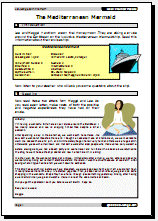
The speaking part of the Cambridge B2 First exam lasts about 14 minutes and comprises four parts. In the first part, the candidate and examiner have a short general chat. In the second part, the candidates are given photos to compare and contrast. In part three, the collaborative task, the candidates work together on a problem and in the final part, the examiner asks more general questions arising from the previous section.
Each worksheet contains a full example of a Speaking section, with Parts One, Two, Three and Four.
Cambridge B2 First (FCE) Speaking - Test Two
Types of holiday / Different homes / Retirement gifts.
1. Students shouldn't give short unresponsive answers to questions.
Examiner: Do you think it's better to study in a library or at home? Candidate: At home.
Candidate: At home. You are more comfortable there, although there are also more distractions.
2. Students should avoid short yes/no answers to closed questions.
Examiner: Do you find English a hard language? Candidate: Yes.
Candidate: Yes, the grammar is very different from my language and that can be difficult for me.

★ Special Coupon Discount★
$8 off Lifetime Membership. Enter coupon code 8LIFE at registration.
(valid for this month)
Cambridge B2 First (FCE) Speaking - Test Five
Domestic animals / Household chores / Children's party.
1. Encourage students to ask for clarification if there's something they haven't understood clearly. Five seconds doing this is better than two minutes lost through an answer to the wrong question.
2. Teach students to navigate their way around a photograph very ably - over here, down there, above the. to the right of. in the top right corner, etc.
3. Students should learn to talk for 30 seconds, talk for a minute, etc and have a clear idea what that feels like.
Cambridge B2 First (FCE) Speaking - Test Eight
Buying fresh fruit / Spare time activities / Traffic problems.
1. Students should use the time when they are not talking to THINK. They need to listen to what the other candidate is saying, as they may be asked to comment on it, but they can also organise their own thoughts. This is not the time to stare at the wall or think about what they'll have for dinner!
2. Students should try, if possible, to get some practice speaking with the partner they'll sit the exam with. This is not always possible, but a benefit if the opportunity exists.
3. Some effort should be made to make the collaborative task sound 'natural', not an exchange of memorised snippets of language. This should include: agreement, disagreement, explanation, clarification, questions, etc.
| Back to the B2 First main page |